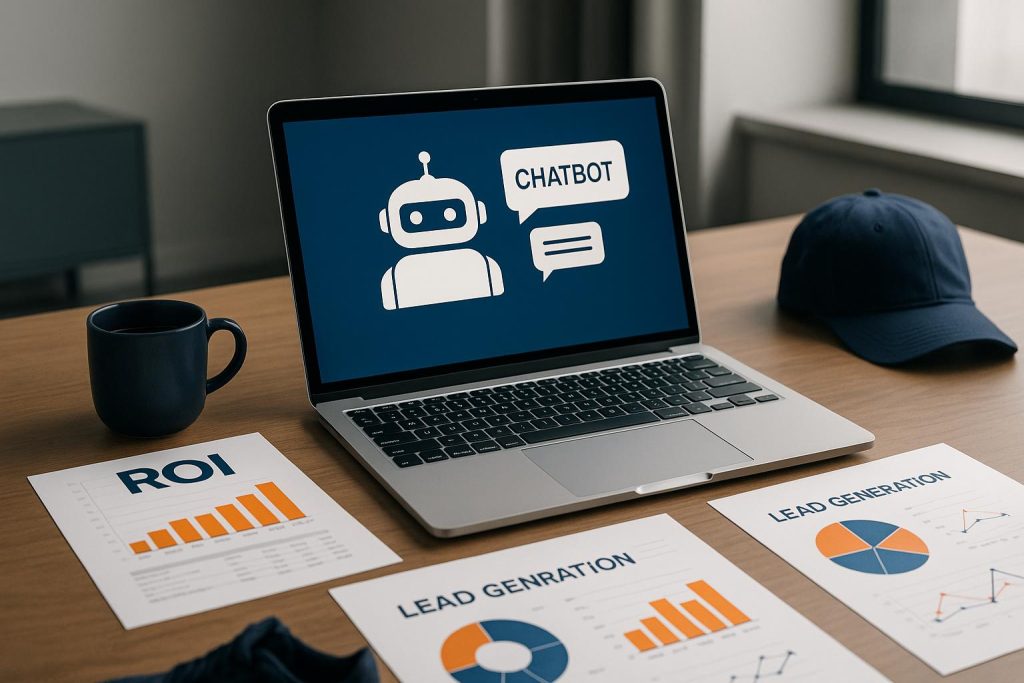Want to know if your chatbot is worth the investment? Measuring ROI for lead generation boils down to two key factors: how much extra revenue it brings in and how much it saves on operational costs. Here’s the quick breakdown:
- Formula: ROI (%) = [(Gains – Investment) / Investment] × 100
- Revenue Gains: More leads, higher conversion rates, and faster responses.
- Cost Savings: Reduced labor costs, fewer support tickets, and 24/7 lead handling.
- Example: A chatbot improving conversion rates from 2.1% to 5.4% on 20,000 visitors can generate $66,000 more monthly revenue with a $199 monthly cost, yielding a ~33,065% ROI.
To measure ROI effectively:
- Track key metrics like leads generated, conversion rates, and cost reductions.
- Use tools like Google Analytics, HubSpot, or Salesforce for data tracking.
- Regularly review and optimize chatbot performance.
How to Measure Chatbot ROI (and Actually Prove It) | Optimly
What Is Chatbot ROI for Lead Generation
Chatbot ROI for lead generation measures how much financial return businesses gain by converting potential customers into paying clients, compared to the costs invested. The formula to calculate this is straightforward: ROI (%) = [(Gains – Investment) / Investment] × 100. Here, "gains" include both increased revenue from qualified leads and savings from operational efficiencies. This calculation provides a clear way to evaluate the financial impact of chatbots on lead generation.
How to Define Chatbot ROI in Lead Generation
To estimate revenue gains, multiply the additional qualified leads by the average value per lead, then apply your close rate. For instance, if a website with 20,000 visitors per month improves its conversion rate from 2.1% to 5.4%, it generates 660 extra leads. At $400 per lead and a 25% close rate, this translates to about $66,000 in extra monthly revenue.
Cost savings are another crucial factor. Automating routine inquiries with a chatbot can significantly reduce labor costs. For example, a company handling 8,000 queries per month – each taking around 5 minutes at a labor cost of $21 per hour – spends approximately $118,084 annually. By switching to a chatbot with an annual cost of $50,000, the company saves nearly $68,084 per year.
Additionally, chatbots provide faster response times, which can help businesses capture leads more efficiently and gain an edge over competitors.
How Lead Quality Affects ROI
Beyond revenue and cost savings, the quality of leads plays a big role in ROI. High-quality leads are more likely to convert, generate higher revenue per lead, and require less effort from sales teams.
Chatbots excel in lead qualification by using consistent, data-driven methods. Unlike human agents – who may vary in their approach – chatbots ask the same targeted questions every time. This consistency can boost lead qualification rates from around 70% with human agents to about 85% with chatbots.
This improvement in qualification rates directly impacts ROI, as a higher percentage of prospects turn into paying customers, even if the total number of leads remains the same.
| Metric | Human | Chatbot |
|---|---|---|
| Consistency | Variable | 100% consistent |
| Availability | Business hours only | 24/7 lead capture |
| Qualification Rate | ~70% accuracy | 85% accuracy |
| Response Time | ~48 hours average | ~3 seconds |
Key Metrics to Track for Chatbot ROI
Measuring the right metrics is essential to understand your chatbot’s impact on lead generation. By focusing on metrics linked to revenue and cost savings, you can assess whether your chatbot is delivering results.
Performance Metrics for Lead Generation
- Number of leads generated: Keep an eye on how many unique users complete your chatbot’s lead capture steps, such as submitting contact details, booking demos, or requesting quotes. This serves as a baseline to evaluate how your chatbot stacks up against previous lead generation methods.
- Conversion rate improvement: Compare the percentage of website visitors who turn into leads before and after implementing your chatbot. Many businesses have seen their conversion rates more than double, maximizing lead generation from the same traffic.
- Speed-to-lead: Quick responses are crucial. Research from Harvard Business Review shows that 35–50% of sales go to the vendor that responds first. Chatbots can interact with leads in seconds, cutting down response times dramatically compared to human agents.
- Average lead value: Calculate the financial worth of each lead by dividing total revenue from leads by the number of leads generated during a specific period. For instance, if 100 leads result in $40,000 in sales, each lead’s value is $400.
- After-hours lead capture rate: Measure how many leads are captured outside standard business hours. Chatbots excel here, with some businesses reporting after-hours lead capture rates of 5.2%, ensuring potential leads aren’t missed.
Cost Metrics for Chatbot Implementation
While performance metrics highlight revenue gains, cost metrics help you understand operational efficiency.
- Setup costs: This includes the initial investment in creating or purchasing a chatbot. Basic chatbots can cost between $500 and $1,000 to set up, while more advanced systems may require a higher investment.
- Monthly fees: These typically range from $45 to $300, with premium platforms costing around $199.
- Staff training costs: Factor in the time and resources needed to train your team on managing the chatbot. For example, if 5 employees each need 10 hours of training at $25 per hour, the total cost would be $1,250.
- Maintenance and optimization costs: Ongoing expenses for updates, content tweaks, and system improvements. Some businesses handle this internally, while others may budget for external support or additional software.
Chatbots can also deliver significant savings compared to human agents. For example, if human agents cost around $168,084 annually, switching to a $50,000 annual chatbot solution could save approximately $118,084 per year, while also enhancing lead quality.
| Cost Category | Annual Investment | Monthly Equivalent |
|---|---|---|
| Entry-level Setup | $500–$1,000 | $42–$83 |
| Platform Subscription | $2,388 | $199 |
| Staff Training | $1,250 | $104 (first year) |
| Total First Year | $4,138–$4,638 | $345–$386 |
How to Calculate Chatbot ROI Step by Step
Measuring your chatbot’s ROI doesn’t have to be complicated. By following a clear formula and breaking it down into manageable steps, you can evaluate its financial impact on your business.
Understanding the ROI Formula
The formula for calculating chatbot ROI is simple:
ROI = [(Total Gains – Total Costs) / Total Costs] × 100.
- Total Gains: These include all the financial benefits your chatbot generates. Think of revenue from increased lead conversions, savings on labor costs, leads captured outside business hours, and faster responses that improve win rates.
- Total Costs: This includes everything you spend to implement and maintain the chatbot – setup fees, licensing, maintenance, staff training, and integration costs. Don’t forget to account for the time your team spends managing the chatbot.
Once you understand the formula, you can apply it step by step using your own data.
Step-by-Step Calculation Process
- Gather baseline data
Start by collecting key metrics like monthly visitors, current conversion rates, average lead value, close rates, and your existing costs for support and sales. You can typically find this information in tools like web analytics platforms, CRM systems, and sales reports. - Estimate potential improvements
Use benchmarks to project possible gains. For example, chatbots often achieve a 5.4% conversion rate, 67% support deflection, and an 85% improvement in lead qualification. Use conservative estimates to avoid overpromising. - Calculate additional leads and revenue
Use this formula to estimate new leads:
Additional Leads = Visitors × (Chatbot Conversion % – Current Conversion %)
For instance, if your site gets 20,000 visitors and your conversion rate rises from 2.1% to 5.4%, that’s 660 extra leads. At $400 per lead with a 25% close rate, this translates to $66,000 in additional monthly revenue. - Quantify cost savings
Factor in labor savings from fewer manual inquiries and faster responses. If your chatbot handles 67% of support questions that previously required human agents, calculate the corresponding reduction in labor costs. - Calculate ROI
Add up your total gains (revenue increases plus cost savings) and subtract your total costs (all chatbot-related expenses). Plug these numbers into the ROI formula to get your percentage return.
Here’s a real-world example:
A business with 20,000 monthly visitors increased its conversion rate from 2.1% to 5.4% after implementing a chatbot. This generated 660 extra leads per month. With a $400 lead value and a 25% close rate, the business earned an additional $66,000 monthly. Given a $199 monthly chatbot cost, the ROI was an impressive ~33,065%.
Visualizing Metrics with a Table
A table can make it easier to compare key metrics before and after implementing a chatbot. It’s also a great way to present your findings to stakeholders. Here’s an example:
| Metric | Before Chatbot | After Chatbot | Change |
|---|---|---|---|
| Monthly Visitors | 20,000 | 20,000 | – |
| Conversion Rate | 2.1% | 5.4% | +3.3% |
| Leads Generated | 420 | 1,080 | +660 |
| Lead Value | $400 | $400 | – |
| Close Rate | 25% | 25% | – |
| Monthly Revenue | $42,000 | $108,000 | +$66,000 |
| Chatbot Cost | – | $199 | – |
| ROI | – | ~33,065% | – |
This table clearly shows how a chatbot can boost performance across critical areas, making it easier to justify the investment.
sbb-itb-d6d4d8b
Tools and Methods for Tracking Chatbot Performance
Once you’ve calculated your chatbot’s ROI, the next step is to keep a close eye on its performance. Ongoing tracking is crucial to ensure your chatbot continues to deliver results and improve lead generation. Using analytics tools that integrate seamlessly with your existing systems can provide real-time insights, helping you connect performance data directly to ROI metrics.
Analytics Tools and ROI Calculators
CRM-integrated tools like Salesforce, HubSpot, and Zoho allow you to track key lead generation metrics by syncing chatbot data with your customer relationship management system. This integration makes it easier to follow the entire customer journey – from the initial chatbot interaction to closing a deal. Additionally, Google Analytics can help you track conversion funnels, offering insights into how users interact with your chatbot and where they might drop off.
For more advanced insights, platforms like Botpress, Qualified, and Aisera specialize in chatbot analytics. These tools provide detailed data on conversation flows, user engagement, and lead qualification rates.
If you’re looking to measure your chatbot’s impact, ROI calculators tailored for chatbots can be incredibly helpful. These calculators typically require you to input data such as monthly website visitors, conversion rates (both current and chatbot-driven), average lead value, lead-to-customer close rates, and implementation costs. By comparing these metrics before and after deploying your chatbot, you can clearly see its effect on your ROI.
Here’s a practical example: A SaaS company using a chatbot integrated with HubSpot CRM leveraged real-time analytics to track lead qualification rates and conversion times. They discovered that after-hours leads were being overlooked. By optimizing their chatbot to engage with users during off-hours, they increased qualified leads by 20% and reduced costs associated with missed opportunities and manual follow-ups.
Setting Up Real-Time Monitoring
Real-time monitoring takes performance tracking a step further by giving you instant access to live interaction data. This allows you to quickly adjust your lead generation strategies based on what’s happening in the moment. Tracking live user interactions, pinpointing drop-off points, and monitoring conversion events as they occur are all essential steps.
To set this up, you can integrate your chatbot platform with tools like Power BI or Tableau. Make sure to configure data mapping, event triggers, and automated alerts for real-time tracking. Some chatbot platforms come with built-in analytics dashboards, while others allow API-based integrations for custom reporting and visualization.
Key metrics to monitor in real time include:
- Number of chatbot interactions
- Leads generated
- Lead qualification rates
- Conversion rates
- Average response times
- After-hours lead capture
Additional metrics, such as support deflection rates and cost savings from reduced manual tasks, can give you a more comprehensive view of your chatbot’s overall performance.
Looking ahead, digital marketing strategies are shifting toward behavioral triggers that adapt in real time based on user engagement. This means your chatbot’s ability to respond instantly and guide prospects through the conversion funnel will become even more important.
To stay on top of performance changes, set up automated alerts for any significant shifts in metrics. For example, if there’s a sudden drop in lead generation or a spike in conversion rates, you can quickly investigate and make adjustments.
Finally, many analytics platforms offer visualization tools that let you create custom dashboards. With features like line graphs and bar charts, you can easily track trends over time and showcase improvements in lead generation and ROI to stakeholders.
Common Challenges in Measuring Chatbot ROI and How to Fix Them
Even with advanced tracking tools, measuring the return on investment (ROI) for chatbots can be tricky. Missteps in calculations can lead to missed opportunities for improvement. Here’s a look at two common challenges and how to address them effectively.
Problems with Attributing Leads to Chatbots
One major hurdle is figuring out how much credit a chatbot deserves in a customer’s often-complex journey. Today’s buyers interact across multiple channels – chatbots, emails, and sales calls – sometimes on different devices. This fragmented journey makes it easy to misattribute interactions, especially if tracking systems don’t talk to each other.
To tackle this, consider multi-touch attribution models. These models spread credit across all the touchpoints a customer interacts with, offering a clearer picture of how each channel contributes to the final conversion. For instance:
- Linear models give equal credit to every interaction.
- Time-decay models prioritize touchpoints closer to conversion.
- Position-based models focus on the first and last interactions but still account for middle steps.
For better accuracy, connect your chatbot analytics to your CRM system. Also, use UTM parameters to track user activity across devices and sessions. This ensures chatbot engagements are properly accounted for in your ROI calculations.
How to Quantify Cost Savings
Pinpointing cost savings from chatbots – like reduced manual labor and fewer support tickets – can be challenging since these benefits often don’t show up directly in financial reports.
Labor savings are one of the most noticeable areas. For example, if your chatbot handles tasks like qualifying leads that previously required human effort, you can measure the hours saved. If it reduces support emails by 60%, calculate the time saved per email and multiply it by your team’s average hourly wage.
Faster response times also bring measurable benefits. According to research from Harvard Business Review, 35-50% of sales go to the vendor that responds first. Chatbots provide instant, 24/7 responses, helping you capture leads that might otherwise go to competitors. To quantify this, track after-hours interactions and multiply the additional leads by their average value and your close rate.
Support deflection is another area where chatbots excel. They can resolve a significant portion of inquiries without human involvement – industry data shows a 67% deflection rate is possible. Businesses often see an initial 20-30% drop in manual support requests, which can grow to 60-65% with optimization. To measure this, track the reduction in support tickets, emails, or form submissions.
To calculate the financial impact of these efficiency gains, start by establishing baseline metrics before deploying the chatbot. Monitor support ticket volumes, lead qualification hours, and response times. Once the chatbot is in place, compare the changes and translate the saved time into dollar amounts using your team’s hourly rates or operational costs.
Here’s a quick breakdown of how to measure these savings:
| Cost Saving Area | How to Measure | Calculation Method |
|---|---|---|
| Reduced Manual Labor | Hours saved on lead qualification | Hours saved × Average hourly wage |
| Support Deflection | Decrease in support tickets | Tickets avoided × Cost per ticket |
| After-Hours Lead Capture | Leads generated outside business hours | Additional leads × Lead value × Close rate |
| Faster Response Times | Improved speed-to-lead metrics | Conversion rate improvement × Lead volume |
Key Takeaways for Measuring Chatbot ROI
To effectively measure chatbot ROI, focus on metrics that highlight both revenue growth and cost reduction. These two factors combined provide a clear picture of your chatbot’s overall value. For instance, tracking revenue gains from improved conversion rates alongside savings from reduced manual labor can showcase the true impact of your chatbot.
Pay special attention to the volume and quality of leads. High-quality leads have a more substantial effect on ROI. For example, businesses have reported an impressive average ROI of 847% within just 90 days by enhancing lead qualification. This improvement has led to qualification rates climbing as high as 85%, as previously discussed.
Use the ROI formula – [(Gains – Investment) / Investment] × 100 – to quantify your chatbot’s contributions. Adding concrete before-and-after comparisons, such as boosting conversion rates from 2.1% to 5.4% or cutting support emails by 30%, strengthens the credibility of your ROI analysis.
Make it a practice to review ROI on a quarterly basis. Regular assessments can help identify performance trends and uncover opportunities for improvement. Remember, chatbot optimization is not a one-and-done task but an ongoing process.
Even modest improvements can deliver remarkable outcomes. For example, a slight 1% bump in conversion rates and a 30% reduction in support inquiries among 10,000 monthly visitors can result in an ROI of 2,914%, as highlighted earlier.
For professional advice on AI-powered lead generation and performance tracking, consider reaching out to the experts at JeffLizik.com.
FAQs
How can I measure my chatbot’s ROI for lead generation effectively?
To determine your chatbot’s ROI for lead generation, begin by focusing on essential metrics like the number of leads it generates, the conversion rates of those leads, and the revenue tied directly to chatbot interactions. Use this formula to calculate ROI: (Revenue from chatbot-generated leads − Chatbot costs) ÷ Chatbot costs × 100.
Make sure you have proper tracking systems in place to monitor chatbot-driven activities, such as completed lead forms or sales. Tools like CRM integrations and analytics platforms can help you collect precise data. Regularly evaluate your chatbot’s performance and make adjustments to ensure it’s driving the best possible results for lead generation.
What challenges do businesses face when calculating chatbot ROI for lead generation, and how can they address them?
Calculating the ROI of a chatbot for lead generation can be a bit of a puzzle, thanks to a few common hurdles. One major issue is figuring out how to properly credit the chatbot for generating leads. Customers often interact with multiple channels before they convert, making it tough to pinpoint the chatbot’s exact contribution. A smart way to tackle this is by using multi-touch attribution models, which allow businesses to track and assign credit across all the touchpoints, including the chatbot.
Another sticking point is assigning a monetary value to the leads generated by the chatbot. Many businesses find it challenging to put a dollar figure on these leads. A practical solution? Dive into historical data to determine the average revenue per lead. This gives you a solid benchmark to work with when evaluating the chatbot’s performance.
Finally, it’s easy to miss out on the less obvious benefits. Think about the time saved by automating lead qualification or the boost in customer engagement the chatbot provides. Including these indirect advantages in your ROI calculations can give you a fuller picture of how the chatbot is driving value for your business.
How can I evaluate the quality of leads my chatbot generates and its impact on ROI?
To measure how well your chatbot is generating quality leads and affecting your ROI, start by focusing on key metrics like conversion rates, lead qualification rates, and customer acquisition costs (CAC). Quality leads tend to show strong engagement, match your target audience, and are more likely to turn into paying customers.
Once you have those metrics, calculate your ROI by comparing the revenue earned from chatbot-generated leads to the total investment in the chatbot. Use this simple formula: ROI = [(Revenue from leads – Chatbot costs) / Chatbot costs] x 100. For instance, if your chatbot costs $5,000 and brings in $20,000 in revenue, your ROI would be 300%.
Keep an eye on these metrics regularly and tweak your chatbot strategy as needed to ensure it keeps attracting and converting valuable leads.









